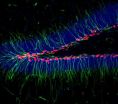(Press-News.org) For patients with glioma, the most common primary brain tumor, new findings may explain why current therapies fail to eradicate the cancer. A UCSF-led team of scientists has identified for the first time that progenitor rather than neural stem cells underly a type of glioma called oligodendroglioma. This distinction explains why oligodendroglioma is more responsive to therapy than other brain tumors such as glioblastoma multiforme.
The finding is significant, the researchers say, because it gives cancer doctors and researchers new cellular pathways to target in developing therapies. It also updates current beliefs – that brain tumors derive from neural stem cells – with the indication that, since oligodendroglioma derives from progenitor cells, stem cell-specific therapies may not hold promise for treating those types of brain tumors.
Different life expectancies for two types of brain tumors were what first piqued the scientists' interest.
"With treatment, patients with oligodendroglioma can live many years longer than patients with gliobastoma multiforme. For two types of tumor that appear similar, the outcome is so different. We were interested in understanding this," said William A. Weiss, MD, PhD, corresponding author and professor in the Departments of Neurology, Pediatrics and Neurological Surgery.
"There has been a great deal of research into the molecular basis of glial tumors, but current therapies have not advanced much. Many remain ineffective and the majority of patients die from the disease, so fresh strategies are desperately needed. The ability we now have to sub-classify tumors and differentiate gliomas based on differences in cell of origin will be helpful in the search for more effective treatments," Weiss added.
Findings are described in the December 14 issue of the journal Cancer Cell and online at http://www.cell.com/cancer-cell/.
Glioblastomas arise from the glial cells in the brain and are known to be highly aggressive, resulting in a life expectancy of just six to 12 months after diagnosis, according to the National Brain Tumor Society. Glial and neuronal cells both arise from progenitor cells, which in turn arise from neural stem cells. Oligodendrglial cells are a type of glial cell that supports neuronal cells, insulating them by producing myelin, a substance that promotes communication between neurons.
"Our study shows that tumors can arise from either neural stem cells or progenitor cells, which produce different types of brain cancers that exhibit different responses to therapy," Weiss said.
Using MRI and detailed analyses of both human and mouse tumors, the team discovered that tumor cells differentiate in the brain in two key ways, and the mode of differentiation impacts whether the tumor will be sensitive to therapy. Tumors that arise from neural stem cells such as astrocytomas (of which glioblastoma is the most common) are less sensitive to therapy because dormant stem cell-like tumor cells do not divide unless provoked by certain factors. Tumors that arise from progenitor cells, such as oligodendroglioma, are more sensitive to therapy because progenitor cells are actively dividing.
"These results suggest that oligodendroglioma tumor cells arise from normal oligodendrocyte progenitor cells, and that a progenitor rather than a neural stem cell origin underlies improved prognosis in patients with this tumor," said lead author Anders I. Persson, PhD, assistant professor of Neurology in UCSF's Helen Diller Family Comprehensive Cancer Center.
Since oligodendrogliomas are more sensitive to therapy, the team hypothesized that this sensitivity might be a property of the glial progenitors from which they arise. To test this, they treated stem cells, astrocytomas, progenitors and oligodendrogliomas with the chemotherapeutic used for glioma treatment, temozolomide. They found that stem cells and astrocytoma cells were largely resistant to the drug, but the growth of oligodendroglioma cells and of glial progenitors was vastly stalled.
"By studying the properties and behavior of the precursor cells, we have better clues about which cellular pathways could be effective for therapy, depending on the type of tumor," Persson said. "So for instance, now that we know to determine whether a brain tumor is a progenitor disease or stem cell disease, we could use MRI to make these diagnoses, resulting in faster, more effective treatment for glioma patients."
INFORMATION:
The study was supported by the Swedish Society for Medical Research, Swedish Medical Research Council, Hjarnfonden (the Swedish Brain Foundation), Sandler Postdoctoral Fellowship and the Joel A. Gingras Jr/American Brain Tumor Association Fellowship. Funding was also provided by a Sandler Opportunity Award in Basic Science, National Institutes of Health, Brain Tumor Society, UCSF Academic Senate, Accelerate Brain Cancer Cure and the Burroughs Wellcome Fund.
Additional UCSF authors include Claudia Petritsch, PhD; Fredrik J. Swartling, PhD; Melissa Itsara; David D. Goldenberg; Scott Vandenberg, MD, PhD; Kim N. Nguyen; Stanislava Yakovenko; Jennifer Ayers-Ringler; Mitchel S. Berger, MD; Gabriele Bergers, PhD; and Tracy R. McKnight, PhD.
Authors not affiliated with UCSF include Steven Goldman, MD, PhD, Frasier Sim, PhD and Romane Auvergne, PhD, from the University of Rochester; Akiko Nishiyama from the University of Connecticut; and William B. Stallcup, PhD, from Burnham Institute for Medical Research.
UCSF is a leading university dedicated to promoting health worldwide through advanced biomedical research, graduate-level education in the life sciences and health professions, and excellence in patient care.
Follow UCSF on Twitter.com/ucsfscience
Cell of origin for brain tumors may predict response to therapy
2010-12-15
ELSE PRESS RELEASES FROM THIS DATE:
Once upon a time in the Intensive Care Unit ...
2010-12-15
MONTREAL, December 14, 2010 – The first few days after birth is an important time when babies learn to recognize the sound of their parents' voice and the parents in turn bond with their children. However, the separation between parents and newborns admitted to the intensive care unit can be very difficult and can disrupt the early development of this relationship.
Jan Lariviere, a nurse in the neonatal clinic and the Neonatal Intensive Care Unit (NICU) at The Montreal Children's Hospital (MCH) of the MUHC led an innovative research project that suggests reading to newborns ...
Optical water quality assessment
2010-12-15
Madison, WI December 14, 2010 -- Scientists at the U.S. Geological Survey (USGS) have proven that measuring fluorescence could improve source water monitoring during a study of the McKenzie River in Oregon. The study was designed to assess the amount, type and source of dissolved organic carbon that exists in all sources of drinking water.
Dissolved organic carbon can react with chlorine during water treatment and form halogenated compounds, commonly referred to as disinfection byproducts. Some of these byproducts are regulated by the U.S. Environmental Protection Agency, ...
Human umbilical cord blood cells found to enhance survival and maturation of key brain cells
2010-12-15
Laboratory culture (in vitro) studies examining the activity of human umbilical cord blood cells (HUCB) on experimental models of central nervous system aging, injury and disease, have shown that HUCBs provide a 'trophic effect' (nutritional effect) that enhances survival and maturation of hippocampal neurons harvested from both young and old laboratory animals.
"As we age, cognitive function tends to decline," said Alison E. Willing, PhD, a professor in the University of South Florida's (USF) Department of Neurosurgery and Brain repair and lead author for a study published ...
Tiny channels carry big information
2010-12-15
They say it's the little things that count, and that certainly holds true for the channels in transmembrane proteins, which are small enough to allow ions or molecules of a certain size to pass through, while keeping out larger objects. Artificial fluidic nanochannels that mimic the capabilities of transmembrane proteins are highly prized for a number of advanced technologies. However, it has been difficult to make individual artificial channels of this size – until now.
Researchers with the U.S. Department of Energy (DOE)'s Lawrence Berkeley National Laboratory (Berkeley ...
New survey device gets better information on teenage sexual behavior
2010-12-15
PROVIDENCE, R.I. [Brown University] — Brown University sociologists have developed a device to gather more reliable data about risky sexual behavior among Ethiopian teenagers and young adults than conventional face-to-face interviews can produce. Simple, portable, low-cost, and low-tech, the group's new nonverbal response card allows respondents to communicate nonverbally and confidentially during face-to-face interviews. Professors of sociology David Lindstrom and Dennis Hogan, and postdoctoral research associate Megan Klein Hattori published their findings in the December ...
Special section on stigma in Perspectives on Psychological Science: Group differences, not deficits
2010-12-15
Psychological scientists are faced with the arduous task of identifying distinctions between humans without stigmatizing groups of people based on these differences. In this special section of Perspectives on Psychological Science, a journal of the Association for Psychological Science, experts present reasons for why differences in gender, race, sexual orientation, and culture should not be framed as deficits within the field of psychology.
Stigma From Psychological Science: Group Differences, Not Deficits—Introduction to Stigma Special Section (http://pps.sagepub.com/content/5/6/687.full) ...
CSHL scientists identify elusive neuronal targets of deep brain stimulation
2010-12-15
Cold Spring Harbor, N.Y. – Shooting steady pulses of electricity through slender electrodes into a brain area that controls complex behaviors has proven to be effective against several therapeutically stubborn neurological and neuropsychiatric disorders. Now, a new study has found that this technique, called deep brain stimulation (DBS), targets the same class of neuronal cells that are known to respond to physical exercise and drugs such as Prozac.
The study, led by Associate Professor Grigori Enikolopov, Ph.D., of Cold Spring Harbor Laboratory (CSHL), is the cover ...
The ethics of biofuels
2010-12-15
In the world-wide race to develop energy sources that are seen as "green" because they are renewable and less greenhouse gas-intensive, sometimes the most basic questions remain unanswered.
In a paper released today by the School of Public Policy at the University of Calgary, authors Michal Moore, Senior Fellow, and Sarah M. Jordaan at Harvard University in the Department of Earth and Planetary Sciences, look at the basic question of whether these energy sources are ethical.
In addition to arguing that the greenhouse gas benefits of biofuel are overstated by many policymakers, ...
Researchers discover new signaling pathway linked to inflammatory disease
2010-12-15
Scientists at the University of California, San Diego School of Medicine have described for the first time a key inhibitory role for the IL-1 signaling pathway in the human innate immune system, providing novel insights into human inflammatory bowel disease (IBD) and potential new treatments.
The research, led by Jose M. Gonzalez-Navajas, PhD, and Eyal Raz, MD, a professor of medicine at UC San Diego, is published as a Brief Definitive Report in the December issue of The Journal of Experimental Medicine.
The researchers report that signaling by the interleukin 1 receptor ...
Fighting flu in newborns begins in pregnancy
2010-12-15
A three-year study by Yale School of Medicine researchers has found that vaccinating pregnant women against influenza is over 90 percent effective in preventing their infants from being hospitalized with influenza in the first six months of life. Published in the December 15 issue of Clinical Infectious Diseases, the study builds on preliminary data the research team presented last year at the Infectious Disease Society of America in Philadelphia.
Influenza is a major cause of serious respiratory disease in pregnant women and of hospitalization in infants. Although the ...



